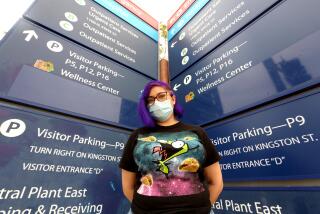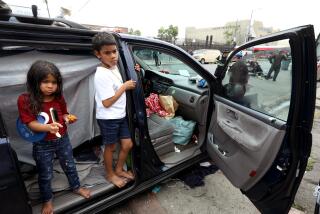Clinic Nears 50 Years of Help to Poor Children
- Share via
LONG BEACH — The Grant family is going through hard times.
Jimmy is unemployed and his wife, Denise, works only part time. The 25-year-old parents do not have medical insurance and cannot afford the fees most doctors would charge to take care of their three young children.
But the Grant children continue to get medical care when they are ill as well as preventive care such as checkups and vaccinations.
They are some of the almost 9,000 youngsters seen each year by doctors at the Children’s Clinic, a nonprofit medical facility that has treated children from low-income families for almost 50 years.
“Without the clinic it would be hard,” Denise Grant said. “Myself, I haven’t been to the doctor because of the price. Paying someone $75 would mean less food on the table.”
Founded in 1939
The clinic, founded by five pediatricians in 1939, has almost 60 volunteer doctors in 18 specialties. Operating out of basement offices at Memorial Medical Center of Long Beach, doctors see about 90 patients a day, five days a week, Monday through Friday.
One recent morning the clinic was swarming with children and their parents, waiting for appointments in one of the clinic’s 14 examination rooms.
The clinic’s doctors treat a large portion of the medically indigent children in the North Long Beach area, according to medical director Dr. Elisa Nicholas and clinic manager Pimmie R. Lopez.
“Our families are the working poor and the nonworking poor,” Nicholas said. “Most of the patients have no insurance, inadequate insurance or have insurance but are so poor they cannot afford the deductible.
“Without the clinic, the only alternative for those who cannot pay is the county system. But many people do not have cars to get to county facilities and when they get there the wait is often very long.
“Here we can offer treatment for longer chronic illnesses as well as encourage parents to bring in children for preventive care.”
Two years ago, a cumulative deficit of $286,000 threatened the clinic itself and for a short time forced doctors to turn away patients.
But by reducing expenses and replacing some paid workers with volunteers the clinic has returned to financial health and should break even this year, said Donald Budai, president of the clinic’s board of directors.
Budai added that the clinic is always looking for more funds as well as more volunteers.
About 70% of the patients are Latino and many of the staffers are fluent in Spanish, Nicholas said. But the clinic needs more translators fluent in Southeast Asian languages.
Youngsters Translate
Sometimes the young patients are better able to communicate than their parents, who have not been exposed to as much English.
Seven-year-old Emerson Valasquez recently helped his mother Elesa Blanca explain why she uses the clinic.
“She cannot afford other doctors and if the clinic was not here she would not know where to go,” Emerson said, translating his mother’s Spanish as he fidgeted in a plastic chair.
“She is also here because she likes the doctors, they are nice and they often speak both languages,” he said.
Emerson also commended the doctors, saying, “They give you the right medicine.”
Patients are charged a small fee, but most of the clinic’s budget of about $750,000 comes from donations and government reimbursements through the MediCal program, Lopez said.
Some Pay Monthly
“We screen families for their ability to pay,” he said. “Most pay only $15 a visit and $5 for each prescription.
“People are good about paying, even if they are only paying a dollar a month, which is not unusual.” The clinic does not turn over unpaid accounts to collection agencies, he said.
For the physicians, working in the clinic is a valuable experience, according to Dr. Michael Khatibi-Nejad, a recent graduate from the medical school at UC Irvine.
“Many of the people here have special problems,” he said while helping a toddler down from an examination table. “We see a lot of people from Mexico and a lot of comparatively rare illnesses such as hepatitis or parasitic problems.”
Working in the clinic is rewarding, medical director Nicholas said.
“The staff is not working here for money but for the people in the clinic,” she said.
“The best reward is getting a thank you from a mom, that’s what is fun about working here.”
More to Read
Sign up for Essential California
The most important California stories and recommendations in your inbox every morning.
You may occasionally receive promotional content from the Los Angeles Times.













